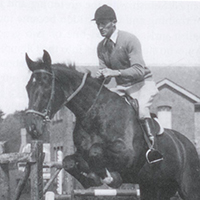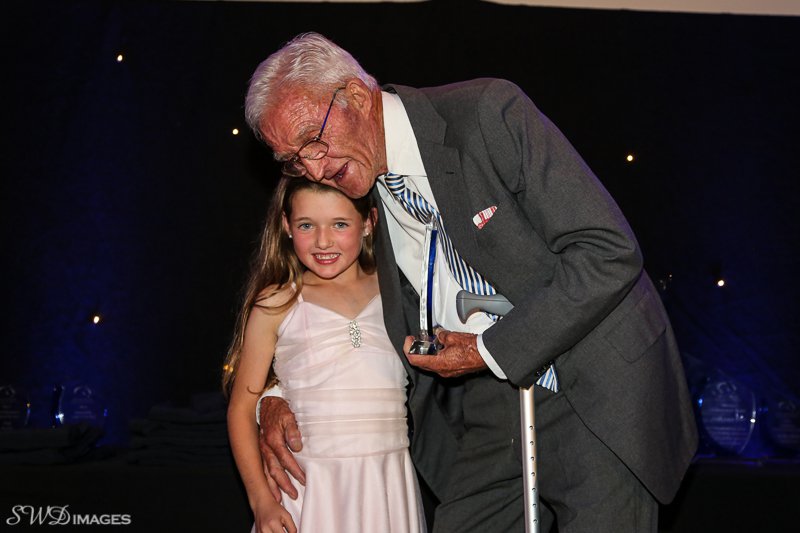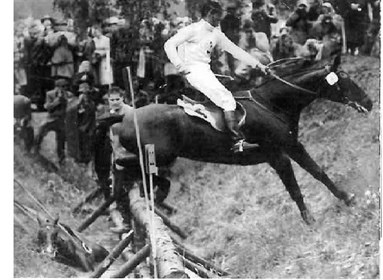
One of the pioneer heroes of Australian eventing Bunty Thompson has passed away. Here is a review of his book that charts the course of the first Olympic team:

Book Review: Bunty Blazes the Trail
by Chris Hector
I guess the first thing you have to say about the recently published Trailblazers – Australia’s first Olympic Equestrians by Wyatt – better known in the horse world as ‘Bunty’ – Thompson, is that the author is an accomplished story teller. With the assistance of Petronella McGovern, Bunty has produced a book that just asks to be read in one sitting… at least that’s what happened for me. It truly is a ripping yarn, a tale of outrageous bravado! Imagine, Australia, a country yet to hold its first One Day Event, let alone a Three Day, decides it will up and send a team to the 3DE at the Olympic Games of 1956.
And guess what? They darn near take home a medal at their first try; indeed if the EFA hadn’t stuffed up the selection process (sound familiar?) it is almost certain we would have won a medal.
This is also the story of a remarkable trainer, Franz Mairinger, who took on a group of raw Aussie riders, who’d never competed in a Three Day event and, in fifteen months, had them ready to take on the world.
Sadly for Australia, the equestrian events of the 1956 Games were not held in Melbourne, but for reasons of quarantine, in Stockholm. But it was the opportunity that the Games presented that lead another visionary, Sam Hordern to push for the establishment of an Equestrian Federation, affiliated to the FEI, and for Australia to compete in 1956.
Two of the team that travelled to England – David Wood and John Winchester – had actually been to the previous Games in Helsinki. The others – eventers, Brian Crago, Ernie Barker and Bunty – along with the sole showjumper, Bert Jacobs, had no idea of what they were going to… Visiting British instructor, John Sheddon (who’d won the first Badminton in 1949) advised the EFA to concentrate on an eventing team which was a huge blow for the talented women riders of the time, since they were barred from competing in the Three Day Event.
The team took six Australian horses with them, intending to buy another six in England. All the Australian horses were donated by their owners, and all twelve were to be sold at the end of the adventure to help pay for it. Only Bert Jacobs and the showjumping mare, Dumbell were selected as a combination – the other five horses and the five riders were selected independently, with the team manager Alec Creswick reserving the right to allocate (and re-allocate) horses as he thought best.
There was a selection trial, won by Laurie Morgan on Gold Ross. Apparently Mr (later Sir) Creswick didn’t like Laurie’s attitude so he was left out of the team. But Laurie Morgan was not a quitter. At his own expense he loaded Gold Ross on a ship and headed to England, determined to beat the selected Aussies on every available occasion, which he did. Mairinger decided his horses and riders were not ready for the 1955 Badminton so they attended as spectators, watching Frank Weldon win on Kilbarry, with Laurie and Gold Ross in fourth place.
The next year at Badminton, the Aussie team members had to complete the event to qualify to compete at Stockholm. They did. Brian Crago was 9th on Radar and 17th on Dandy, Bunty Thompson and Brown Sugar were 11th, Ernie Barker and Marcus Adair was 13th , and David and Radiant, 18th. And Laurie? Well he was fourth again, but this did not cause Creswick to change his mind.

Bunty and Brown Sugar
When they got to Stockholm, the team – Brian Crago on Radar, Ernie Barker and Dandy (Ernie would have preferred Marcus Adair) and Bunty and Brown Sugar – must have wondered whether qualifying was a very good idea. The course was huge, and enormously difficult, and made even more difficult when the rain bucketed down the night before the cross country. Australia was in 11th place after the dressage, they needed to go well on what was looking like a killer course…
It was. A Turkish rider finished the event screaming as he crossed the finishing line with a broken leg. An American fell as he crossed the finish line, he was concussed from an earlier fall, a Romanian finished with three busted ribs and a fractured shoulder; one horse had been put down (it’s the one in the ditch in the famous photo of Bunty jumping Trakehner at fence 22. The Swedish rider had two stops and pointed the horse at the fence a third time whereupon it collapsed into the ditch), another was seriously injured, and many were utterly exhausted. There had been 62 falls and 129 refusals. Fence 22 alone caused 12 falls, 28 refusals and three eliminations. Only 21 riders out of 55 had finished without a fall – Brian Crago and Bunty Thompson were two of them.
Ernie Barker who had been the first rider on course, fell with his horse on the steeple track. He described it in a letter home: “Luckily, except for a scraped face and plenty of black mud, neither of us were the worst for wear. I had the bridle in my hand but with the wet and the mud, I couldn’t get the throat lash undone to put it on again. Finally to save time, I wrapped the reins around his nose and he jumped the last two fences without a bit.”
On course Ernie had a fall at fence 3, a stop at fence 8 for 296 penalties but the main thing was, Australia was one of the few nations home with a team intact, and we were sitting in 4th spot going into the showjumping – Britain was in the lead, followed by Germany, then the Canadians.
The drama was not quite over. During the night, a fire broke out in the riding school next to the stables. The Aussies smelt the smoke and while their horses were safe, helped get others, closer to the fire, away.
The showjumping track was as diabolical as the cross country, if somewhat less dangerous. Alas the Canadians held their spot and the team positions did not change. Australia had almost taken home a medal at their first outing. Brian Crago had finished 11th individually, while Bunty was 14th.
In the showjumping Showjumping, Bert Jacobs and Dumbell were unlucky to encounter a monster course, and Bert – ever the horseman – retired. The mare went on to become one of Britain’s leading showjumpers with Ted Williams, riding for that country in a number of Nations Cups.
Sadly the horses were sold after the event for the grand total of £9,130 which helped pay some of the £35,000 that the exercise had cost. Such a pity that the horse could not return to Australia to push up the standard – but all the riders did, and all played a key role in fostering equestrian sport in Australia. None more so than Bunty who was co-opted to the NSW Committee of the EFA in 1957, then the following year, elected to the Council of the RAS of NSW. He was appointed Technical Delegate and Assistant Course Designer for NSW – and established his own event at his property, Goonamurrah.
That first Australian team had laid the basis for the gold medal success four years later, Rome, 1960 – they are truly the Trailblazers.
If you are interested in equestrian sport, in particular the development of eventing in Australia, do get a copy of this book. It’s not just the words, there are many wonderful photos, and some simply superb illustrations by Joan Wanklyn. It is a treasure…
To obtain your copy for $29.95 (+ $6 postage) contact Rosenberg Publishing on 02 9654 1502, fax 02 9654 1338 or rosenbergpub@smartchat.net.au
PO Box 6125, Dural Delivery Centre NSW 2158
